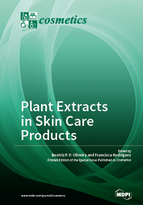Plant Extracts in Skin Care Products
A special issue of Cosmetics (ISSN 2079-9284).
Deadline for manuscript submissions: closed (30 September 2017) | Viewed by 154018
Special Issue Editors
Interests: sustainability; nutritional value; food security; proteins and amino acids; antioxidant compounds; lipid fraction; vitamin E
Special Issues, Collections and Topics in MDPI journals
Interests: plant extracts; green extraction techniques; bioactive compounds; antioxidants; functional food; cosmetics
Special Issues, Collections and Topics in MDPI journals
Special Issue Information
Dear Colleagues,
Currently, there is an increasing interest in cosmetic industry on natural extracts, namely plant extracts. The inclusion of antioxidants in topical formulations can contribute to minimize oxidative stress in the skin, which has been associated with aging. Many herbal agents used in cosmetics have been selected by a process of ‘trial and error’ and, thus, are used based on experience rather than experimental investigation. There is now, however, growing scientific evidence that plants possess a vast and complex arsenal of active ingredients able, not only to calm or smooth, but also actively restore, heal, and protect the human skin. In addition, plant extracts may contain compounds with antimicrobial or other beneficial properties, influencing the formulation of natural and non-chemical cosmetic products. The public trend towards natural and sustainable products is on-going. Although the term “plant extract” inherently purports their beneficial and benign properties, these could have adverse reactions in individuals. Therefore, it is essential to attend to the issue of ensuring quality and safety of these extracts in cosmetic products before embarking on the more arduous task of ensuring efficacy. In view of this underlying principle, the screening of natural plant extracts with scavenging activity for pro-oxidant reactive species is a primary requirement for the development of new topical antioxidant formulations.
This Special Issue is dedicated to highlighting the potentialities of plant extracts on cosmetic products, their composition, and provide new insights into their mechanisms of action in skin.
Dr. M. Beatriz P.P. Oliveira
Dr. Francisca Rodrigues
Guest Editors
Manuscript Submission Information
Manuscripts should be submitted online at www.mdpi.com by registering and logging in to this website. Once you are registered, click here to go to the submission form. Manuscripts can be submitted until the deadline. All submissions that pass pre-check are peer-reviewed. Accepted papers will be published continuously in the journal (as soon as accepted) and will be listed together on the special issue website. Research articles, review articles as well as short communications are invited. For planned papers, a title and short abstract (about 100 words) can be sent to the Editorial Office for announcement on this website.
Submitted manuscripts should not have been published previously, nor be under consideration for publication elsewhere (except conference proceedings papers). All manuscripts are thoroughly refereed through a single-blind peer-review process. A guide for authors and other relevant information for submission of manuscripts is available on the Instructions for Authors page. Cosmetics is an international peer-reviewed open access semimonthly journal published by MDPI.
Please visit the Instructions for Authors page before submitting a manuscript. The Article Processing Charge (APC) for publication in this open access journal is 1800 CHF (Swiss Francs). Submitted papers should be well formatted and use good English. Authors may use MDPI's English editing service prior to publication or during author revisions.
Keywords
- Plant extract
- Composition
- Antioxidant
- Cosmetic, radical scavenging activity







